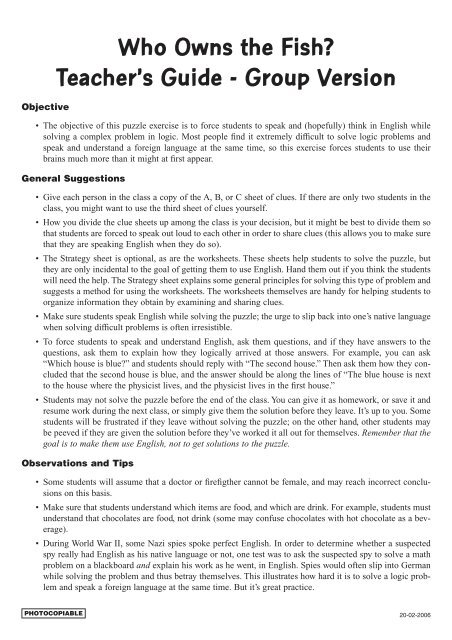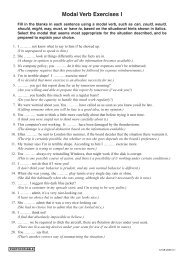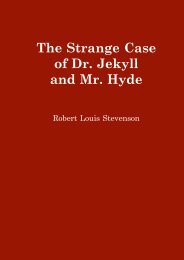Game - Who Owns the Fish Group Version.qxd
Game - Who Owns the Fish Group Version.qxd
Game - Who Owns the Fish Group Version.qxd
Create successful ePaper yourself
Turn your PDF publications into a flip-book with our unique Google optimized e-Paper software.
Objective<br />
<strong>Who</strong> <strong>Owns</strong> <strong>the</strong> <strong>Fish</strong>?<br />
Teacher’s Guide - <strong>Group</strong> <strong>Version</strong><br />
• The objective of this puzzle exercise is to force students to speak and (hopefully) think in English while<br />
solving a complex problem in logic. Most people find it extremely difficult to solve logic problems and<br />
speak and understand a foreign language at <strong>the</strong> same time, so this exercise forces students to use <strong>the</strong>ir<br />
brains much more than it might at first appear.<br />
General Suggestions<br />
• Give each person in <strong>the</strong> class a copy of <strong>the</strong> A, B, or C sheet of clues. If <strong>the</strong>re are only two students in <strong>the</strong><br />
class, you might want to use <strong>the</strong> third sheet of clues yourself.<br />
• How you divide <strong>the</strong> clue sheets up among <strong>the</strong> class is your decision, but it might be best to divide <strong>the</strong>m so<br />
that students are forced to speak out loud to each o<strong>the</strong>r in order to share clues (this allows you to make sure<br />
that <strong>the</strong>y are speaking English when <strong>the</strong>y do so).<br />
• The Strategy sheet is optional, as are <strong>the</strong> worksheets. These sheets help students to solve <strong>the</strong> puzzle, but<br />
<strong>the</strong>y are only incidental to <strong>the</strong> goal of getting <strong>the</strong>m to use English. Hand <strong>the</strong>m out if you think <strong>the</strong> students<br />
will need <strong>the</strong> help. The Strategy sheet explains some general principles for solving this type of problem and<br />
suggests a method for using <strong>the</strong> worksheets. The worksheets <strong>the</strong>mselves are handy for helping students to<br />
organize information <strong>the</strong>y obtain by examining and sharing clues.<br />
• Make sure students speak English while solving <strong>the</strong> puzzle; <strong>the</strong> urge to slip back into one’s native language<br />
when solving difficult problems is often irresistible.<br />
• To force students to speak and understand English, ask <strong>the</strong>m questions, and if <strong>the</strong>y have answers to <strong>the</strong><br />
questions, ask <strong>the</strong>m to explain how <strong>the</strong>y logically arrived at those answers. For example, you can ask<br />
“Which house is blue?” and students should reply with “The second house.” Then ask <strong>the</strong>m how <strong>the</strong>y concluded<br />
that <strong>the</strong> second house is blue, and <strong>the</strong> answer should be along <strong>the</strong> lines of “The blue house is next<br />
to <strong>the</strong> house where <strong>the</strong> physicist lives, and <strong>the</strong> physicist lives in <strong>the</strong> first house.”<br />
• Students may not solve <strong>the</strong> puzzle before <strong>the</strong> end of <strong>the</strong> class. You can give it as homework, or save it and<br />
resume work during <strong>the</strong> next class, or simply give <strong>the</strong>m <strong>the</strong> solution before <strong>the</strong>y leave. It’s up to you. Some<br />
students will be frustrated if <strong>the</strong>y leave without solving <strong>the</strong> puzzle; on <strong>the</strong> o<strong>the</strong>r hand, o<strong>the</strong>r students may<br />
be peeved if <strong>the</strong>y are given <strong>the</strong> solution before <strong>the</strong>y’ve worked it all out for <strong>the</strong>mselves. Remember that <strong>the</strong><br />
goal is to make <strong>the</strong>m use English, not to get solutions to <strong>the</strong> puzzle.<br />
Observations and Tips<br />
• Some students will assume that a doctor or firefig<strong>the</strong>r cannot be female, and may reach incorrect conclusions<br />
on this basis.<br />
• Make sure that students understand which items are food, and which are drink. For example, students must<br />
understand that chocolates are food, not drink (some may confuse chocolates with hot chocolate as a beverage).<br />
• During World War II, some Nazi spies spoke perfect English. In order to determine whe<strong>the</strong>r a suspected<br />
spy really had English as his native language or not, one test was to ask <strong>the</strong> suspected spy to solve a math<br />
problem on a blackboard and explain his work as he went, in English. Spies would often slip into German<br />
while solving <strong>the</strong> problem and thus betray <strong>the</strong>mselves. This illustrates how hard it is to solve a logic problem<br />
and speak a foreign language at <strong>the</strong> same time. But it’s great practice.<br />
PHOTOCOPIABLE 20-02-2006





